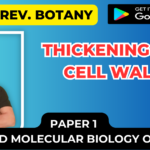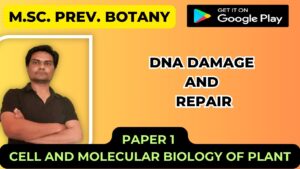![]()
SPECIALIZED CELL TYPES
CELLS OF BASIC GROUND TISSUE SYSTEM
- Parenchyma cells are the generalized multipurpose cells in plants .
- Most parenchyma cell have thin primary wall those varies from spherical to barrel like in shape .parenchyma cell store food reserves as a potato tuber (starch storing parenchyma).the parenchyma cell of green leaves a specialized for photosynthesis these cell contain numerous large chlorophylls and are called chlorenchyma.
- Other parenchyma cells are specialized for the transport of solute through the cell membrane .These cells have a greatly enlarged area due to the highly convoluted inner surface of the cell.
- Transfer cells are found in the nectarines where the extensive membrane houses transport channels that secrete sugar and other nectar components to the exterior of the cell.
- Collenchyma cell function in the support of the growing tissue. Individual collenchyma cells are long and narrow and have unevenly thickened primary walls.
- Collenchyma cell for a cable of thousands of cells that together can provide membrane support while stem or leaves elongate.
- Collenchyma in the veins of the leaves form the strings of celery stages. Sclerenchyma cells function in the support of tissues that are expanding.
- Sclerenchyma cells are long narrow with a thick, hard, rigid secondary wall .Unlike parenchyma and collenchyma cells that are living cells, sclerenchyma cells are dead at maturity.
- The cell’s function in mechanical support is carried out by the strong cell wall. Sclerenchyma fibers make natural woody tissue and also form long strands in the leaves and stem of many plants .
- Natural fiber ropes such as those from hemp or the sisal plant are made up of thousands of sclerenchyma cells.
- Some sclerenchyma cell called sclereids much shorter than fibers, these form the hard layers of shells and peach pits and small cluster of sclereids form in pear fruits

PARENCHYMA CELL

COLLENCHYMA CELL

SCLERENCHYMA CELL
CELLS OF THE DERMAL SYSTEM
- Epidermal cell form the surface layer of the plant ,
- The typical epidermal cell are flat and form a continuous layer with no spaces between the cell .
- Each epidermal cell secretes hydrophobic polymer cutin on the surface , which reduces the amount of water lost by evaporation .
- Most cell also secrete waxes on the surface of cutin which reduce transpiration as well as wettability of the leaves epidermal cell of green leaves contain chloroplast allowing light to penetrate for the photosynthesis.
- Epidermal cell of petals contain anthocyanin pigment within the vacuoles or oranges that carry pigment within the plastids, giving rise to bright colors.
- Guard cells are specialized epidermal cells that function as small pores in the plant surface, allowing the carbon dioxide needed for photosynthesis to diffuse from the external atmosphere into the chlorenchyma tissue .
- Guard cell are crescent shape , contain green chloroplast ,and are rapidly change there shape in response to changes in wide status.
- As guard cells take up water ,the pore opens and as water evaporates the pore closes. The two guard cells and a pore are called stomata. T
- trichomes are hair like cells that project from the surface of plant.
- They function to reduce water loss by evaporation and trapping water vapor near the plant surface .
- In some plant trichome are glandular and secrete sticky or toxic substance that repel insect herbivores .

STOMATAL CELL

TRICHOME CELL (DERMAL SYSTEM)
CELLS OF VASCULAR TISSUE SYSTEM
- The vascular tissue system is composed of both xylem and phloem tissue.
- Xylem functions to carry water and mineral nutrient absorbed at the root tip throughout the plant, stem and leaves.
- Vessels element are the major tissue involved in the transport of water and the solutes.
- Vessel element are elongated cells with thick secondary wall and the rigid wall keep the vessel element from collapsing.
- Like sclerenchyma vessel element are dead at maturity ,so that each cell are empty tubes .
- Before vessel element die the cell protoplast releases enzyme that degrade the cell wall ends of the cell forming a perforation as a continuous pipe.
- Other xylem cells called tracheids also function in transport of water and solute but are efficient because they lack perforations.
- Xylem tissue also contains sclerenchyma cell function in support and parenchyma cells that function as transfer cell.
- Phloem tissue function to transport the product of photosynthesis from green tissue to parts of the plant that are energy rich carbohydrates required for storage by a process called translocation.
- Sieve element are the cell of phloem that are elongated with primary wall.
- Phloem sap travel under a positive pressure and the thick ,elastic cell walls allow the cells to adjust fluctuation in pressure over a day night cycle.
- Sieve element have large conspicuous pores on the end wall, forming plates.
- The sieve plate pore allow the phloem sap to travel cell to cell along the file of cell called a sieve tube.
- Each phloem element is living, with an intact plasma membrane, and the differential permeability of the membrane prevents solute leaking out of the sieve tube. Sieve tube element lack some other component of the cytoplasm this feature functions to keep the pore unplugged.
- Companion cell parenchyma are associated with sieve elements.
- The nucleus of the companion cell must direct the metabolite to the companion cell itself and of its sister sieve elements.
















